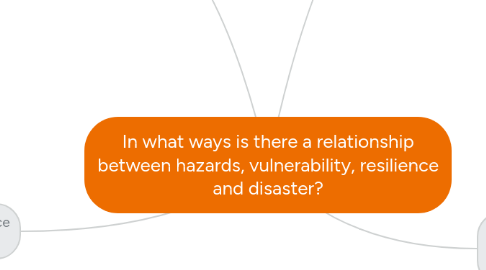
1. Which areas seem to experience regular hazards?
1.1. Parts of Southern Asia, such as India and Burma, experienced regular hazards through the month of July.
1.1.1. For instance this years record heat was been accompanied by abnormal severe flooding across parts of Asia. The worst monsoon flooding in years killed hundreds of people and forced millions of others from their homes in China, Nepal, Pakistan and India to move.
1.1.1.1. This more intense flooding is due to global warming, this is because warmer air is able to hold more moisture than cooler air.
1.1.2. Later on in July, India experienced an earthquake with a 4.5 magnitude around the areas of Punjab and Rajasthan.
1.1.3. Furthermore very high temperatures of 126 degrees Fahrenheit were recorded in Nasiriyah, Iraq, in mid-July. Towards the end of July temperatures reached 119 degrees Fahrenheit in Abu Dhabi, UAE.
1.1.3.1. These extremely high temperatures are a threat to Southern Asia as severe drought can be caused which has many repercussions.
1.1.4. In the final week of July two earthquakes were recorded in India, one 3.5 and the other 3.7 on the richter scale.
2. How well do countries respond to hazards?
2.1. Seabirds, marine mammals, sea turtles and other wildlife had been under great threat due to vast amounts of rubbish floating around in the ocean.
2.1.1. Therefore a group founded in the Netherlands called the Ocean Cleanup Foundation, are currently testing a prototypes of Floating Barriers that may soon be scouring the worlds oceans to collect all the rubbish.
2.1.1.1. This group has responded well to the threat to sea animals because instead of having to employ vessels to actively gather all the rubbish, they have created barriers to passively collect it by allowing the currents to move the trash into these barriers.
2.2. A blast at Mount Rinjani volcano on the Indonesian island of Lombok spewed a large cloud of ash causing great threat to Indonesian civilians.
2.2.1. Initially the Indonesian government decided to halt flights in and out of the international airport on neighbouring Bali. However two days later Mount Gamalama erupted and so it was decided the airport should completely closed.
2.2.1.1. Closing the airport was the best way for Indonesia to respond to the eruption; it prevented potential injuries or deaths to those flying in and out of Indonesia.
3. What areas of the World seem to experience a variety of hazards?
3.1. Australia endured a variation of hazards throughout the month of July.
3.1.1. For example in the first week of July it was discovered that from January 1st 2017 that every place in Australia will be someplace else. Australia moves around 2.75 inches to the north-northeast each year because of the movement of techtonic plates
3.1.2. Australia's southern coast was threatend by a tsunami following a 6.1 magnitude temblor beneath the Southern Ocean.
3.1.3. In mid-July Natural Earth move- ments were felt in Australia’s Gold ends region.
3.2. Japan experienced a diversity of hazards throughout July, not only on land but also within the Pacific Ocean surrounding the country.
3.2.1. In the first week of July there was an earthquake just off the coast of Japan in the Pacific Ocean measured at a 7.7 magnitude.
3.2.2. Towards the middle of July Japan experienced another earthquake in Tokyo, measuring at 5.0 on the Richter scale.
3.2.3. The most powerful eruption of southern Japan’s Sakurajima volcano since August 2013 occurred towards the end of July. It spewed ash 15,000 feet into the sky. The eruption occurred 5 miles from the port of Kagoshima, a city of more than 600,000 residents.
4. There is a clear relationship between hazards, vulnerability, resilience and disaster
4.1. The more hazardous a country or area is due to threat from natural disasters the more vulnerable civilians are to death, injuries, homelessness, starvation and loss of family and friends.
4.2. Being more vulnerable to hazards can have the effect of making you more and less resilient.
4.2.1. For example if you are living in an MEDC that is vulnerable to hazards you may be more resilient because the government is economically stable enough to educate people on how to deal with hazards, build earthquake proof buildings and make people create their own survival kit before hand. MEDCs can also recover quicker from hazards like tsunamis, earthquakes etc. because they can set up shelters, food banks and start rebuliding their country quickly.
4.2.2. However if a natural disaster affects an LEDC people would be a lot less resilient because their country doesn't have enough money to recover quickly. They would have to wait to receive aid from other countries, which will leave more time for people to become ill or potentially die from starvation, dehydration, spread of disease, falling buildings etc.
4.3. Disaster has a strong relationship between hazards, vunerablilty and resilience because disaster can be the cause for all three.
4.3.1. Disasters can range from landslides to tsunamis , but no matter what the disaster, if the country aren't resilient enough they will become more vulnerable to an assortment of hazards.
